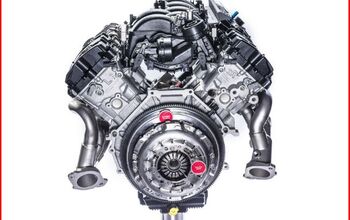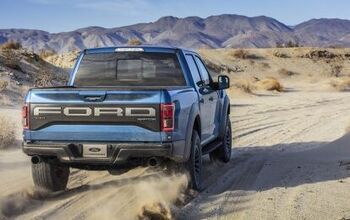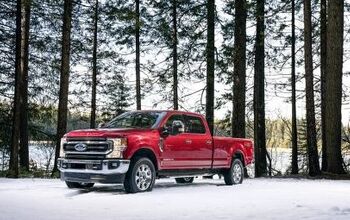2022 Ford Mustang V8 Will Be Down on Power

Ford will be reducing output for the 2022 Mustang GT and Mach 1 coupe. Both models will have 10 fewer horsepower and 10 fewer pound-feet of torque than the previous model year, with the culprit being emission compliance. Changes reportedly only pertain to the 5.0-liter Coyote V8.
That means EcoBoost Mustangs, as well as the Shelby GT500’s supercharged 5.8-liter, will go unaffected. First reported by Ford Authority, the modifications have since been confirmed with the manufacturer. However the automaker hasn’t told us precisely what’s been changed on the Coyote engine, why the decision has been made, how it might impact performance.
We were under the impression that this might have been a global tweak to appease European regulations as the restrictive Euro 7 rules inch closer to reality. But Road & Track managed to get a Ford representative to finger the Low-Emission Vehicle (LEV III) Program adopted by the California Air Resources Board (CARB).
“Changes were made to meet more stringent LEV III regulatory emissions requirements that resulted in a horsepower and torque reduction for the 5.0-liter [V8] engine,” Ford spokesperson Claire Carroll told the outlet.
From R&T:
This means the 2022 Mustang GT should arrive to market with 450 hp and 410 lb-ft, while the Mach 1 will make 470 hp and 410 lb-ft. Those are still respectable figures and remain comparable to offerings from Chevrolet and Dodge. That said, we’ll have to wait and see if customers are willing to accept a less powerful product. This hasn’t been a problem for the Blue Oval in Europe thus far, where the Mustang GT makes just 444 hp and 390 lb-ft of torque.
Ordering for the 2022 Mustang is reportedly open now, with deliveries expected to take place during Q1 of next year.
We’re wondering if sales will be affected and how this will play out for naturally aspirated engines moving forward. One of the main reasons forced induction has made such a colossal comeback is due to emission restrictions. Back in the day, turbos were a slick way of getting the most out of a small engine bay. They’ve since become the only way for some models to keep output high without running afoul of regulatory limits, providing history with an opportunity to repeat itself.
Throughout the 1970s, the V8 looked to be in serious trouble and industry was having problems keeping pace with environmental regulations in general. Large engines were outputting far less than their counterparts from a decade earlier and still managed lackluster fuel economies. By the 1980s, companies began trending toward smaller motors and lighter (arguably shittier) cars to maximize efficiency. But even the most svelte of hatchbacks are a bit of a snooze when the typical inline four (and sometimes V6) was rated well below 100 horsepower. Manufacturers quickly learned that they could breathe some new life into utilitarian powertrains by turbocharging them, resulting in some of my all-time favorite sleeper builds.
However, with modern government officials having reoccurring wet dreams about electrification, V8s may not make a comeback this time around. Engineers have told me that internal combustion vehicles seem to be tapped out in terms of efficiency improvements and the development money is now going toward figuring out a way to make EVs work for the general public thanks to strict regulations. That doesn’t seem to bode well for the Mustang (or its rivals) and we’re wondering if the next few years will result in similarly diminished outputs until the inevitable demise. Though that’s probably how most auto journalists felt in during the prior “Decade of Greed” before things eventually turned around and large V8s came back into fashion.
[Image: Ford Motor Co.]

A staunch consumer advocate tracking industry trends and regulation. Before joining TTAC, Matt spent a decade working for marketing and research firms based in NYC. Clients included several of the world’s largest automakers, global tire brands, and aftermarket part suppliers. Dissatisfied with the corporate world and resentful of having to wear suits everyday, he pivoted to writing about cars. Since then, that man has become an ardent supporter of the right-to-repair movement, been interviewed on the auto industry by national radio broadcasts, driven more rental cars than anyone ever should, participated in amateur rallying events, and received the requisite minimum training as sanctioned by the SCCA. Handy with a wrench, Matt grew up surrounded by Detroit auto workers and managed to get a pizza delivery job before he was legally eligible. He later found himself driving box trucks through Manhattan, guaranteeing future sympathy for actual truckers. He continues to conduct research pertaining to the automotive sector as an independent contractor and has since moved back to his native Michigan, closer to where the cars are born. A contrarian, Matt claims to prefer understeer — stating that front and all-wheel drive vehicles cater best to his driving style.
More by Matt Posky
Latest Car Reviews
Read moreLatest Product Reviews
Read moreRecent Comments
- V8-1 Go hybrid and wait for Toyota to finish its hydrogen engine and generator/separator.
- Poltergeist I expect this will go over about as well as the CR-Z did 15 years ago.
- Michael S6 Welcome redesign from painfully ugly to I may learn to live with this. Too bad that we don't have a front license plate in Michigan.
- Kjhkjlhkjhkljh kljhjkhjklhkjh A prelude is a bad idea. There is already Acura with all the weird sport trims. This will not make back it's R&D money.
- Analoggrotto I don't see a red car here, how blazing stupid are you people?


































Comments
Join the conversation
Best and Brightest if I remember the few times it was talked about in the old days was for sure tongue and cheek. Mostly driven by the blogger mantra of Never Read The Comments. A few times I recall Jack also said it wasn't completely tongue and cheek as the commenters on TTAC tended to be older, better educated and wealthier then other auto blogs per the data they had.
Everything ends eventually. Anyone actually think 20-30 years ago that the majority of personal vehicle drivers would would still be driving ICE vehicles in 2250? 2200? 2150? Where's the cutoff? At some point, something's gotta. And heck, if you want to hate on CA - they just passed a regulation / law that bans sales of new small ICE engines (lawn mowers, leaf blowers, etc) in 2024, IIRC. In my opinion, can't come soon enough. (btw, DC's version of the same law goes into effect this year, so it's not CA being first). I can't wait to NOT be woken up by lawnmowers / weed whackers / chainsaws / leaf blowers on the weekend in the future. I'm going to enjoy the crap out of my Stinger GT, and sure, my next car will probably be electric, once they make a model that can handle track days (and isn't a Tesla) and is reasonably affordable. And guess what - I won't miss the (*@$ rude neighbors who rev their Scat packs / Mustang GTs and race to 75+ in strictly residential areas, just because they're pricks, at all hours of the night. My kids are walking to/from school, I'd like to get a decent night's sleep, etc. Go find a track.